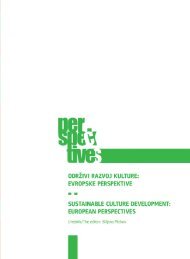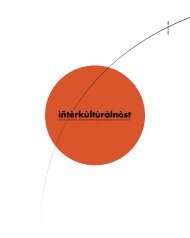Preuzmite kompletan Äasopis broj 2 u PDF formatu - Portal kulture ...
Preuzmite kompletan Äasopis broj 2 u PDF formatu - Portal kulture ...
Preuzmite kompletan Äasopis broj 2 u PDF formatu - Portal kulture ...
Create successful ePaper yourself
Turn your PDF publications into a flip-book with our unique Google optimized e-Paper software.
ïñtérkûltúråłna ìsträživanjá<br />
individuals, to develop curiosity and openness to others and to discover other cultures.<br />
Language learning helps them to see that interaction with individuals having different<br />
social identities and cultures in an enriching experience.” (Council of Europe 16). To all<br />
appearances, it seems that this significant segment of The White Book is more likely to refer<br />
to majority groups, rather than minority or ethnic ones.<br />
Generally speaking, regardless of whether we are talking about members of majority or<br />
minority groups within a society who learn one or more foreign languages, another stumbling<br />
block is the adoption of the concept of different social identities. These identities belong to<br />
different social groups, which is in perfect harmony with the aforementioned „exchange of<br />
views between individuals and groups with different ethnic, cultural, religious and linguistic<br />
backgrounds and heritage”.<br />
One of major cultural issues which are put forward nowadays is whether it is possible<br />
to view the culture of the Balkans as a unique, comprehensive and compact cultural<br />
phenomenon which appears in different forms and in different areas of the Balkans, or as<br />
a parallel existence of several cultures, i.e. different forms of cultural differences within a<br />
relatively clearly defined cultural and civilizational milieu of the Balkans. In most general<br />
terms, it is the existence of numerous identical, identical or similar cultural traits which<br />
allow us to talk about the existence of the Balkan culture and the cultural milieu of this<br />
region. However, Balkan culture per se is still not a uniform phenomenon, as can be seen<br />
in the field, and it is not unique; in certain aspects its forms differ across societies, nations<br />
and regions due to strong social, civilizational, political and religious influences; they left a<br />
lasting impression on cultural activities of the people who were underexposed and eventually<br />
became susceptible to them. That is why Hall in his book The Silent Communication states that<br />
culture is a complex of most various elements connected by human activities, whose origin<br />
is deeply buried in our past. That is why he looks at culture as a form of communication and<br />
defines it like this: „culture is communication and communication is culture” (Hall 1959: 14).<br />
The main feature of Balkan culture is the fact that it is an unambiguously complex<br />
phenomenon which comprises separate collective (i.e. national) instances of cultural<br />
awareness, which means that each individual, who can belong to a nation, or an ethnic/<br />
minority group, is an integral part of the community he/she belongs to and which gives him/<br />
her a corresponding (social, national, political, linguistic) identity. In other words, there is<br />
still a strong impact of identity of society on the individual in the Balkans, and it causes both<br />
the community and the individual to identify themselves as being one and the same thing.<br />
This form of culture is the total opposite of the individualistic one as can be found in Western<br />
Europe or North America, where the identity of the individual is determined by his/her<br />
role in the society, rather than by the fact that he/she belongs to either an ethnic or a social<br />
community. Since there still is no large-scale individualization of the individual, collective<br />
cultures of the Balkans, like other collective cultures, appear to be less tolerant toward<br />
other cultural varieties and patterns of behavior (Burgoon et al. 1996) when compared to<br />
individualistic cultures.<br />
84








